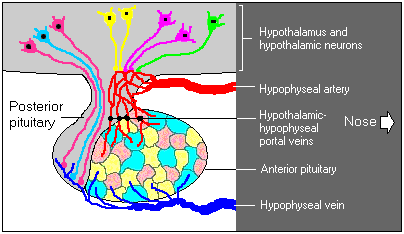1. Describe how the hypothalamus regulates the secretion of anterior pituitary hormones and identify all of the individual hypothalamic regulatory factors. Describe how the hypothalamus controls the activity of the posterior pituitary gland.
- Anterior pituitary: Neurons in the hypothalamus control the secretion through inhibiting and releasing factors. They are released into a primary capillary plexus where they travel through portal veins to a secondary capillary plexus. Over here they stimulate the glandular tissue of the anterior pituitary to secrete its hormones
- Controlled by releasing hormones from the hypothalamus
- Secretion of hormones is under strict control by hypothalamic hormones. These hormones reach the anterior pituitary by a branch of the pypophyseal artery ramifies into a capillary bed in the lower hypothalamus. The hypothalamic hormones destined for anterior pituitary are then secreted into this capillary blood. Blood from these capillaries drain into hypothalamic-hypophyseal portal veins. These portal veins are found between two capillary beds; the hypothalamic-hypophyseal portal veins brain again into another series of capillaries in the anterior pituitary. The capillaries in the AP that carry hormones secreted by that gland coalesce into veins that drain into the systemic venous blood. These veins also collect capillary blood from the posterior pituitary gland. This is important because this allows minute concentrated hormones to be carried directly to their target cells in the AP and not diluted out in the systemic circulation.
- The hormones received from the hypothalamic-hypophyseal portal veins bind to specific AP cells and this is how they regulate the amount of secretion of the AP hormones.
- An example can be the thyrotrophin-releasing hormone (a regulatory factor) from the hypothalamus that binds to the receptors in AP cells called thyrotrophs. This binding stimulates the secretion of TSH (thyroid-stimulating hormone).
Regulatory factors: releasing hormones
- TRH (thyrotrophin-releasing hormone)
- Luteinizing hormone releasing hormone
- Follicle stimulating hormone releasing hormone
- Growth hormone releasing hormone
- Melanocyte stimulating hormone releasing hormone
- Prolactin releasing factor
Inhibiting hormone
- Growth hormone inhibiting hormone
- Corticotrophin-releasing hormone
- Melanocyte stimulating hormone inhibiting hormone
- Prolactin release inhibiting hormone

- Posterior Pituitary: It is a neurosecretory organ. Neurons in the hypothalamus control the secretion directly. The connecting stalk between the hypothalamus and the lobes of the pituitary gland (referred to as infundibulum) carry the hormones of the posterior pituitary from the nuclei in the hypothalamus. The hypothalamic supraoptic nuclei manufactures anti-diuretic hormone and the hypothalamic paraventricular nuclei manufacture oxytocin. These hormones are then stored in pituitary axons until their release is triggered.
- Controlled by nerve stimulation
- This is just an extension of the hypothalamus. It is comprised of axons of hypothalamic neurons which extend downwards as a large bundle behind the anterior pituitary. It also forms the pituitary stalk.
- Nerve ending found in the hypothalamus extend from the supraoptic and paraventricular hypothalamic nuclei to the posterior pituitary. These nerve endings are closely applied to the capillaries and contain storage granules. It directs neurosecretion of PP hormones into the systemic circulation at the endings.
2. What is the role of platelet plug formation in hemostasis? What events occur during platelet plug formation? Describe the circumstances that may induce inappropriate platelet plug formation within intact blood vessels and describe the consequences.
- Platelet adhesion when platelets detect damage to blood vessel and begin to adhere to exposed surfaces
- Platelet release reaction: once the first one is stuck to site of damage, the platelets begin to change. They create extensions so that they can contact each other and release their contents. The platelets have two types of chemical granules held within the cytoplasm of platelets (alpha and dense). Alpha granules contain clotting factors, growth factors and fibroblasts. The dense granules contain ADP, ATP, calcium ions and serotonin. The dense granules release ADP and thromboxane A2 (prostaglandin) stimulating the action of nearby platelets aggregating. Thromboxane and Serotonin also act to cause vasoconstriction.
- Platelet aggregation: ADP from dense granules makes nearby platelets sticky and adhere to the other recruited platelets. When the collection is large enough it creates a platelet plug. This is important because it stops the loss of blood through holes in small vessels.
3. Describe the factors that affect cardiac output in a female athlete who is speed skating toward the finish line in an Olympic race.
4. Excluding the effects of cardiac output and hormones, describe the other factors that may affect blood pressure and blood flow in a middle-aged man who is exercising in an aerobics class.
5. Describe the activation, proliferation, and differentiation of T cells and B cells and briefly describe the functions of the differentiated cells.
6. Describe the factors that are involved in the regulation of respiration in a child who decides to hold his/her breath for as long as possible.
7. Your breakfast consists of a cup of black coffee with sugar as well as a plain bagel covered with cream cheese. Describe the digestion of this breakfast as it passes through each major region of the GI tract.
8. Describe the effects on the urinary system of drinking too much beer.
9. List and briefly describe the mechanisms that prevent acid-base imbalances from appearing in the body. In addition, indicate where each mechanism functions most significantly. (Do not explain any specific chemical reactions.)
10. Describe
a. the factors responsible for promoting lactation, and
b. the mechanism responsible for the cessation of lactation when a mother weans her baby.